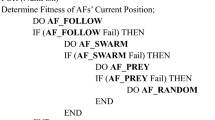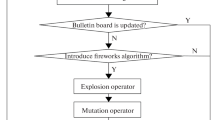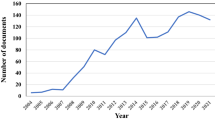Abstract
In the initial period, the peculiarity of artificial fish swarm algorithm is of fast searching speed and high optimization accuracy, but in the later period, the convergence speed is always slow, and artificial fish tend to gather around the local optimum. Therefore, the solving ability of the algorithm becomes weak and the global optimal value is hard to obtain. Considering the introduction of RNA computation based on biomolecular operations, the optimization capability of traditional algorithm can be enhanced effectively. Therefore, RNA computing is introduced to artificial fish swarm algorithm, and a modified artificial fish swarm algorithm is presented on the grounds of RNA computing. In the later period of artificial fish swarm algorithm, the transformation, replacement and recombination operations in RNA computation are applied to increase diversity of artificial fish, so as to further the convergence speed and optimization capability of the algorithm. In the meantime, the improved algorithm, RNA-AFSA, is tested by four typical functions, and the results prove that the modified artificial fish swarm algorithm has better optimization effects in search accuracy, stability, and other aspects.
















Similar content being viewed by others
REFERENCES
Li Xiaolei, Shao Zhijiang, and Qian Jixin, An optimizing method based on autonomous animals: Fish swarm algorithm, Syst. Eng.: Theory Pract., 2002, vol. 22, no. 11, pp. 32–38.
Li Xiao-lei and Qian Ji-xin, Studies on artificial fish swarm optimization algorithm based on decomposition and coordination techniques, J. Circuits Syst., 2003, vol. 8, no. 1, pp. 1–6.
Shen, W., Guo, X., Wu, C., and Wu, D., Forecasting stock indices using radial basis function neural networks optimized by artificial fish swarm algorithm, Knowl.-Based Syst., 2011, vol. 24, no. 3, pp. 378–385.
Liu Dong-lin and Li Le-le, New improved artificial fish swarm algorithm, Comput. Sci., 2017, vol. 44, no. 4, pp. 281–287.
Li Zhen-hao, Li Ying-na, Zhang Chang-sheng, and Li Chuan, Ultrasonic localization method of partial discharge based on immune memory AFSA algorithm, Transducer Microsyst. Technol., 2017, vol. 36, no. 3, pp. 73–75, 83.
Liu Quanming, He Jianqiang, and Zhang Hu, Improved genetic artificial fish swarm optimization algorithm based on the cultural algorithm, J. Shanxi Univ. (Nat. Sci. Ed.), 2018, vol. 41, no. 2, pp. 308–316.
Xu Jian-bo, Dai Yue-ming, and Yan Da-hu, Double adaptive artificial fish swarm optimization algorithm, Microelectron. Comput., 2018, vol. 35, no. 4, pp. 53–57.
Li Jun and Liang Xi-ming, Artificial fish swarm algorithm convergence speed improvement optimization simulation, Comput. Simul., 2018, vol. 35, no. 1, pp. 232–238.
Yao Lingbo, Dai Yueming, and Wang Yan, Opposite adaptive and Gauss mutation artificial fish swarm algorithm, Comput. Eng. Appl., 2018, vol. 54, no. 1, pp. 179–185.
Jia Yimin, Shi Liping, and Yan Xin, Transformer fault diagnosis based on wavelet neural network with improved artificial fish-swarm algorithm, J. Henan Polytech. Univ. (Natl. Sci.), 2019, vol. 38, no. 2, pp. 103–109.
Zhang Xiao-bo, Peng Jin-ye, and Liu Tian, Adaptive visual field and step length of chaotic artificial fish swarm algorithm, Microelectron. Comput., 2019, vol. 36, no. 6, pp. 5–9, 14.
Cukras, A.R., Faulhammer, D., Lipton, R.J., and Landweber, L.F., Chess games: A model for RNA based computation, BioSystems, 1999, vol. 52, no. 1, pp. 35–45.
Faulhammer, D., Cukras, A.R., Lipton, R.J., and Landweber, L.F., Molecular computation: RNA solutions to chess problems, Proc. Natl. Acad. Sci. U. S. A., 2000, vol. 97, no. 4, pp. 1385–1389.
Li Shu-chao, Xu Jin, and Pan Lin-qiang, Operational rules for digital coding of RNA sequences based on DNA computing in high dimensional space, Bull. Sci. Technol., 2003, vol. 19, no. 6, pp. 461–465.
Lin Chun, Li An-gui, and Liu Qin-sheng, Genetic fuzzy C-means algorithm adding in computing of RNA, Comput. Eng. Appl., 2009, vol. 45, no. 24, pp. 50–52.
Wang Kangtai and Wang Ning, A protein inspired RNA genetic algorithm for parameter estimation in hydrocracking of heavy oil, Chem. Eng. J., 2010, vol. 167, no. 1, pp. 228–239.
Li Shuchao and Xu Jin, Digital coding for RNA based on DNA computing, Comput. Eng. Appl., 2003, vol. 39, no. 5, pp. 45–47.
Fei Teng, Zhang Liyi, Bai Yu, and Chen Lei, Improved artificial fish swarm algorithm based on DNA, J. Tianjin Univ. (Sci. Technol.), 2016, vol. 49, no. 6, pp. 581–588.
Author information
Authors and Affiliations
Corresponding author
Ethics declarations
The authors declare no conflict of interest.
About this article
Cite this article
Liyi Zhang, Fu, M., Fei, T. et al. The Artificial Fish Swarm Algorithm Optimized by RNA Computing. Aut. Control Comp. Sci. 55, 346–357 (2021). https://doi.org/10.3103/S0146411621040040
Received:
Revised:
Accepted:
Published:
Issue Date:
DOI: https://doi.org/10.3103/S0146411621040040




